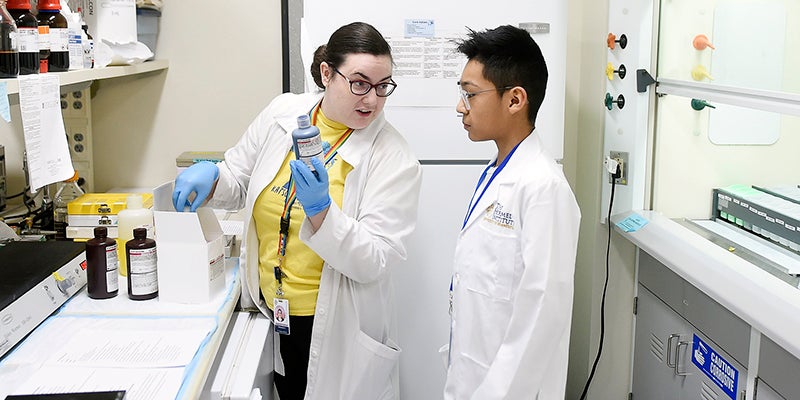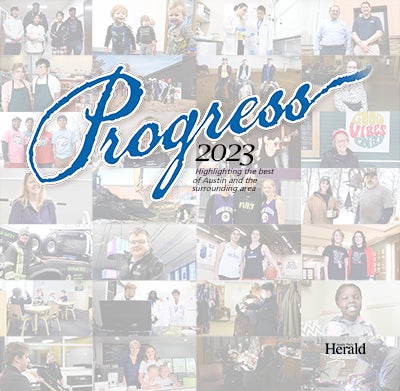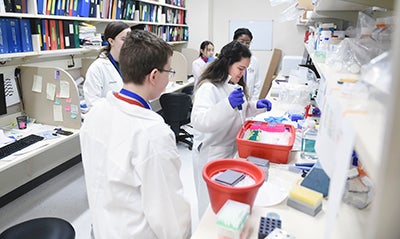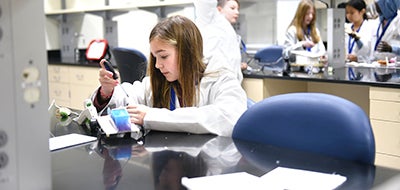Institute program immerses students in lab science
Published 6:00 am Saturday, February 25, 2023

- Hormel Institute Stephanie Holtorf guides student Xavier Vera through lab work. Vera is part of the Institute’s Young Scientist Program. Photos by Eric Johnson/photodesk@austindailyherald.com
|
Getting your Trinity Audio player ready...
|
By Amanda Lillie
A group of about 20 Austin students is getting the opportunity of a lifetime as the inaugural cohort in the Young Scientist Program through The Hormel Institute.
The program, which is the first of its kind in the region, is a partnership between the Institute, IJ Holton Intermediate School and Ellis Middle School.

Find this story and much more in the 2023 edition of Progress, found inside Saturday’s Herald
“These kids are incredibly fortunate and are learning things I don’t think I ever learned as a senior in high school,” said Hormel Institute’s Community Outreach and Education Manager Kelly Vincelette. “It’s just fun to see how excited the kids are.”
The cohort includes students in sixth through eighth grade who were all accepted via application to the program. The ultimate goal is to engage middle schoolers in a way that provides hands-on science experience and fuels their desire to someday enter a science-related career field.
The program was made possible by a generous donation from Austin residents Paul and Joanne Worlein.
Dewey Schara, principal at IJ Holton and Ellis schools, said the partnership has already been a raging success.

Hormel Institute scientist Melike Ozgul-Onal leads students in the Young Scientist Program.
“The kids are just really jazzed,” he said. “The Institute is really making it an authentic professional experience as well. It’s just a blast for the kids. They’re doing really cool experiments with some of the best scientists in the world. I mean come on, it’s a world renowned cancer research facility.”
The 22 students are split into small groups, and each group is paired with an Institute scientist and a specific focus. They meet with their scientist mentors about four hours each month. Some of the students are working with pipetting liquids and learning to properly measure, Vincelette said, while others are working on hypothesis focused projects, growing protein crystals and making solar powered cars.
“They’re going in the same lab, working with the same mentor,” Vincelette explained. “Throughout the experience, they have a portfolio and they’re reflecting on their experience and what they learned.”
As with any lab job, the students had to go through lab safety and Human Resources training before they began the program. They were even fitted for their own personalized lab coats with the Institute logo and their name that they can keep at the end of the year.
“They were cheering and excited,” Vincelette said. “They have their name badge, so the students really feel like employees.”

Alexcia Austin works on a project during a visit to The Hormel Institute as part of the Young Scientist Program.
Schara has heard nothing but positive feedback from the students in the program. He’s especially proud that the demographic of the participants mirrors that of the school district and community.
“We have a very authentic swath of students in the program,” he said. “There might have been a misconception that this was for a certain clientele, and that isn’t the case. The students (are) from every corner of our school district in terms of every demographic, language, learning ability, etc.”
With the success of the program’s inaugural year, Schara has high hopes for the future. Both the Institute and the school district intend for this to be a long-term partnership, and Schara is optimistic it will grow in the future.
“The dream would be that we might be able to have (the students) advance in the program and stick with it through graduation,” he said.
Seeing such young learners discover their enthusiasm for science is fun for the mentors and good for the community at large, as well, Vincelette said.
“I feel like our relationship with the schools is just so mutually beneficial for the future of the community and the students here in Austin,” she said. “Meeting each one of these kids, they are all very, very brilliant and I can see them doing amazing things in the future whether with research or whatever they do.”





